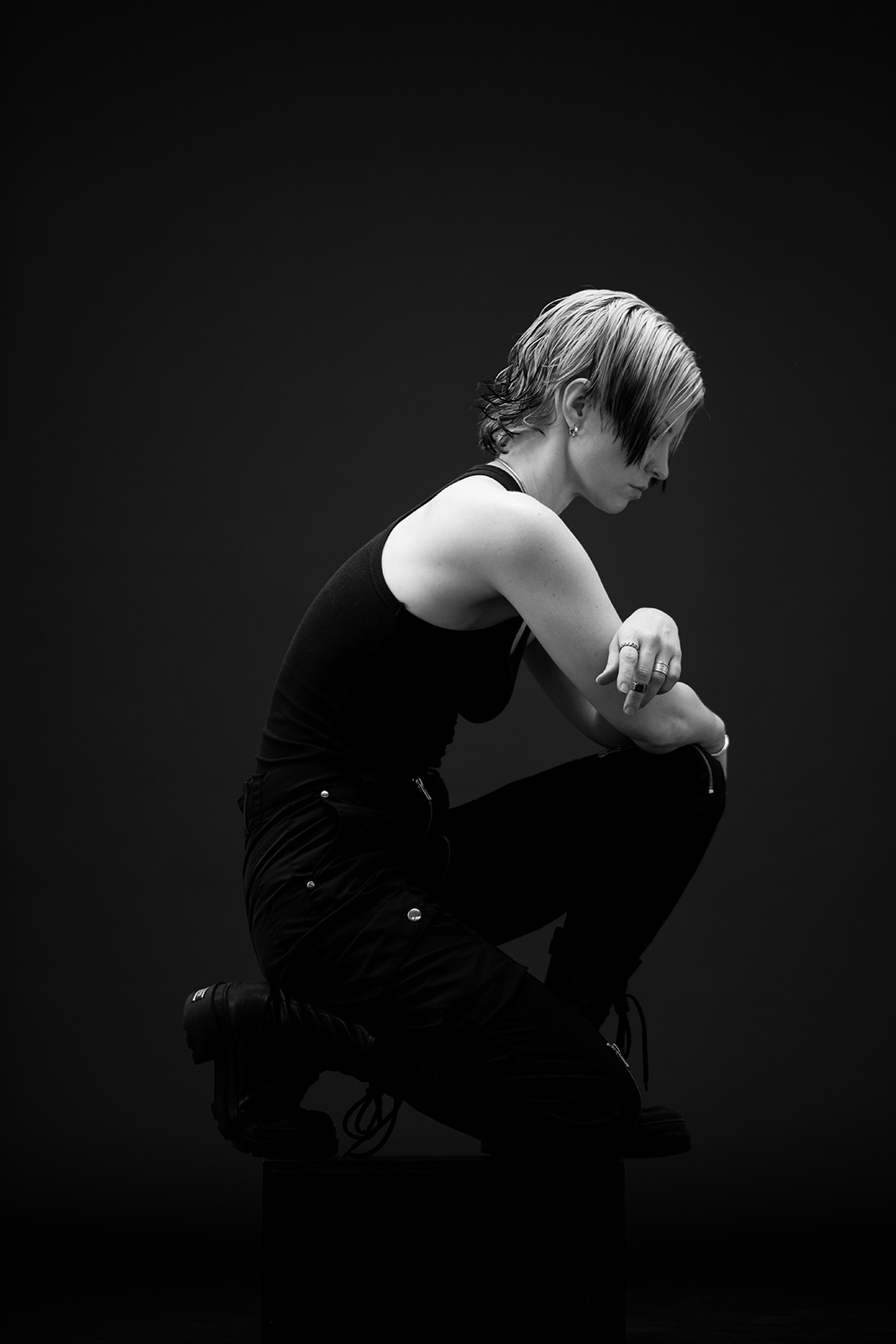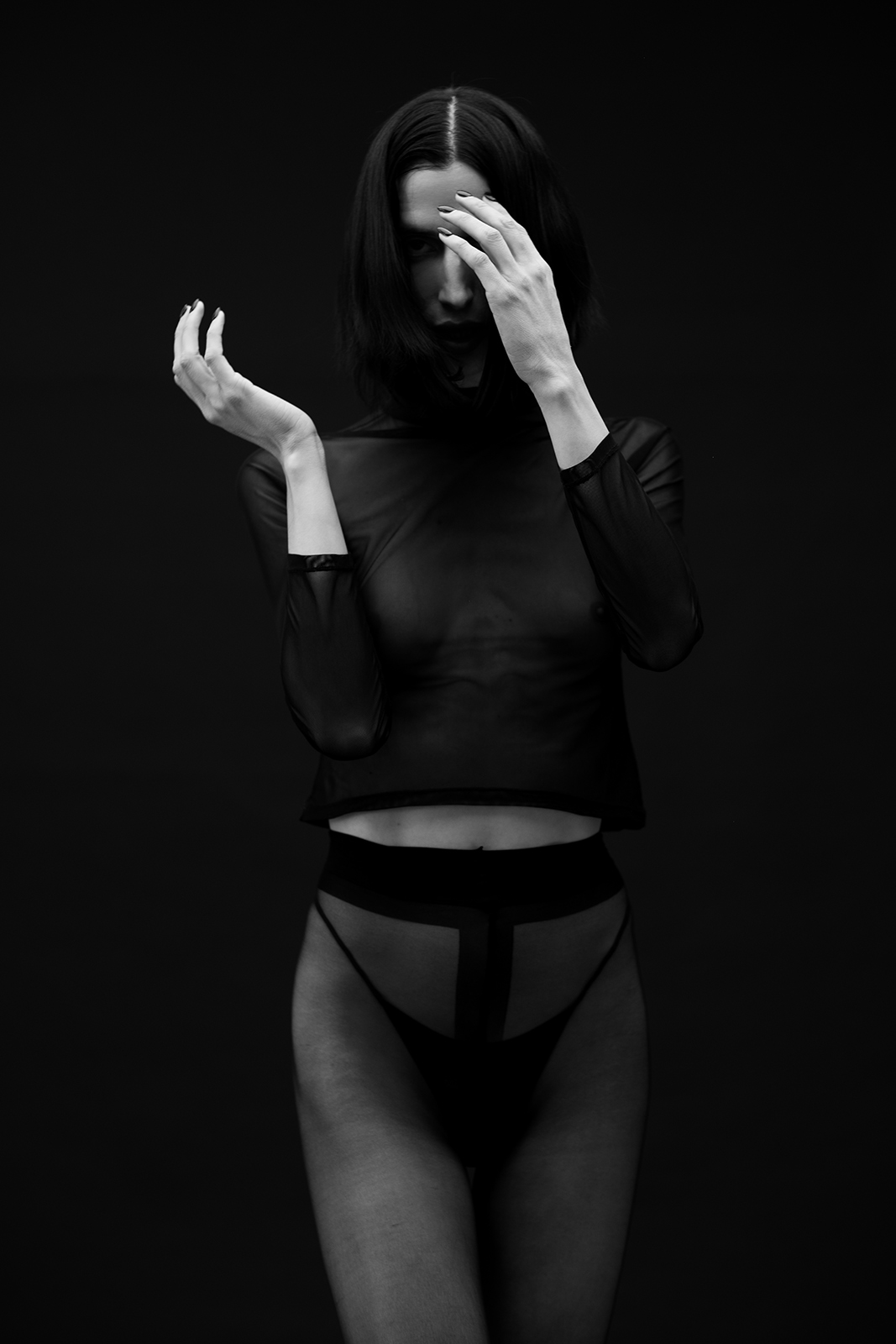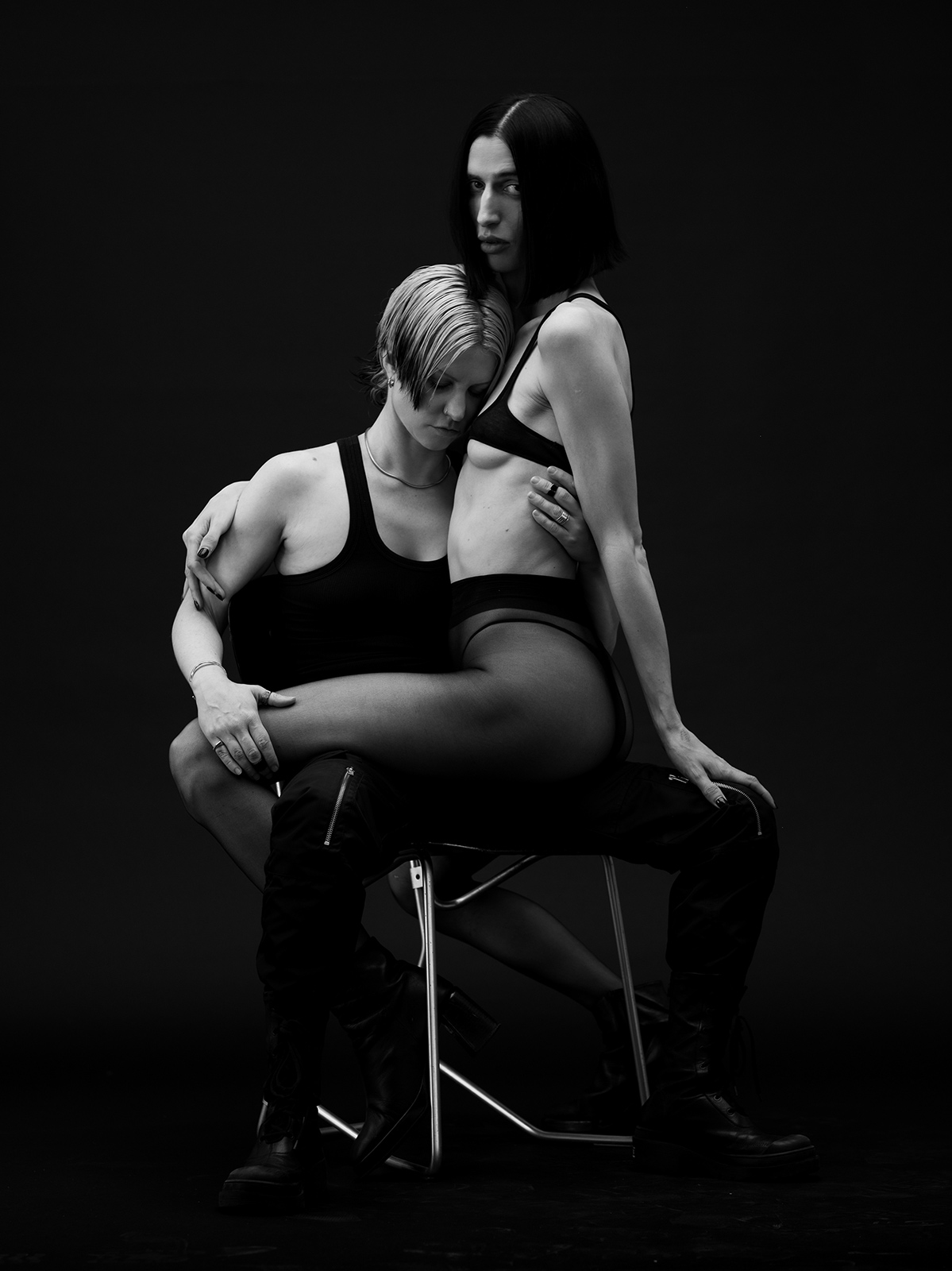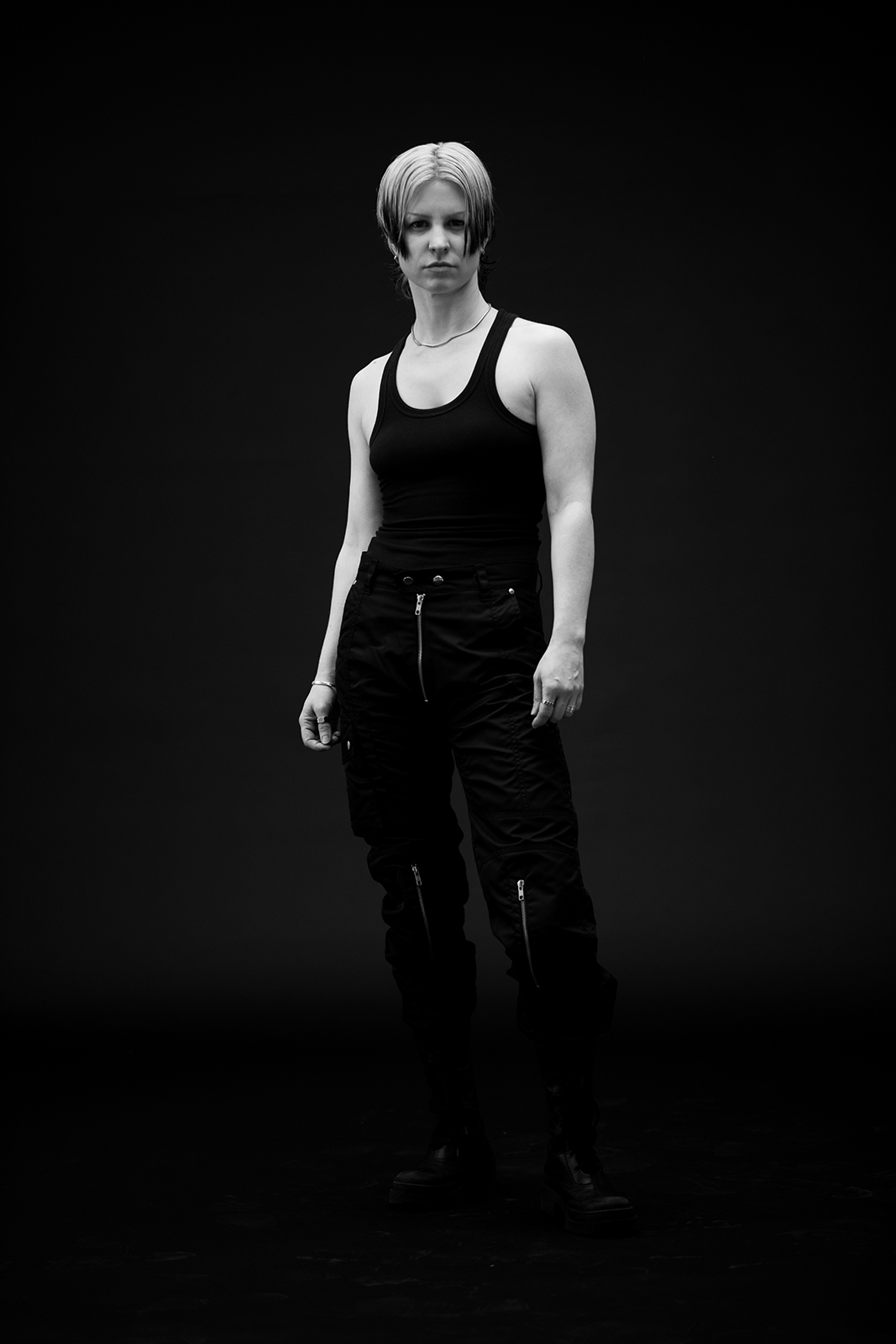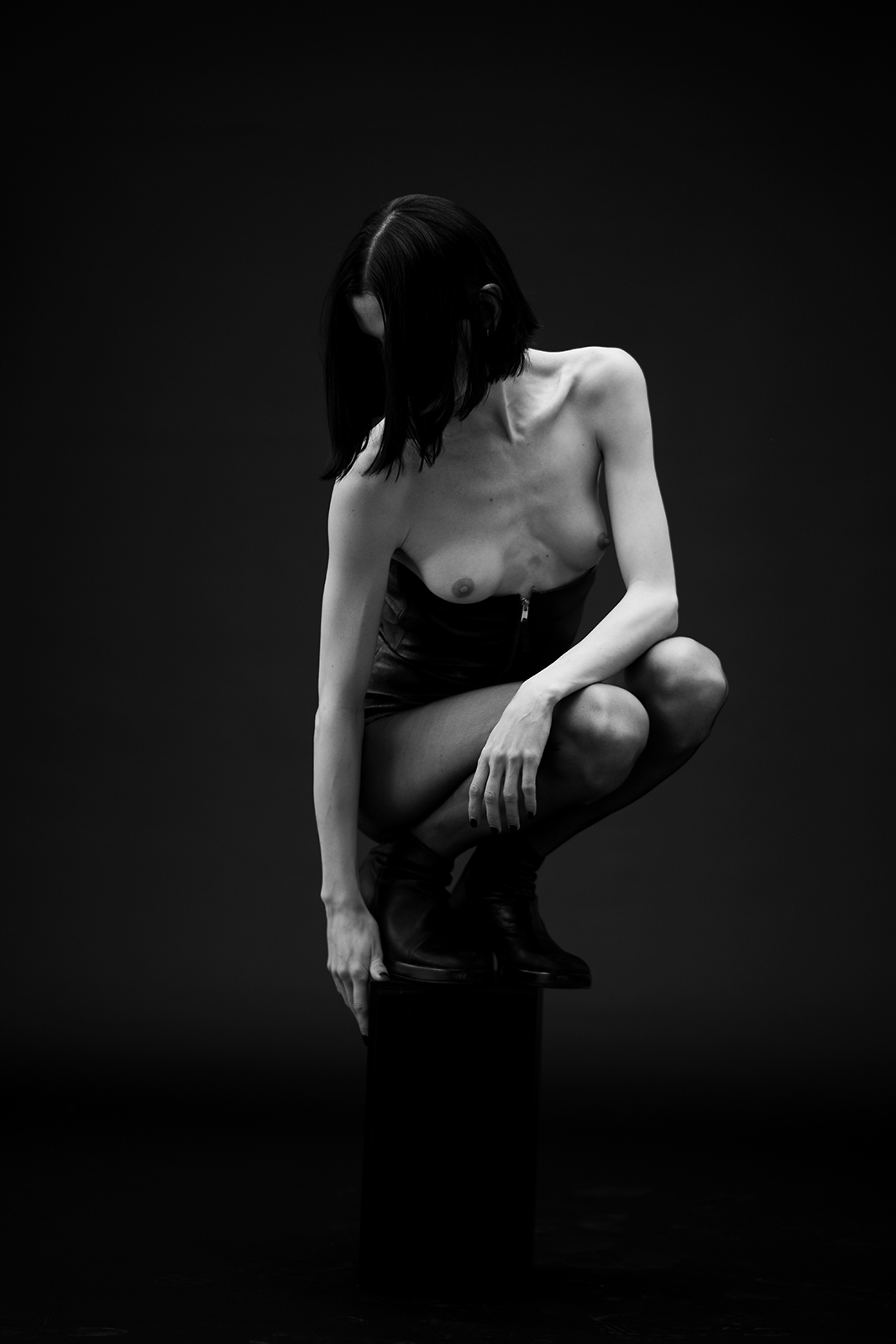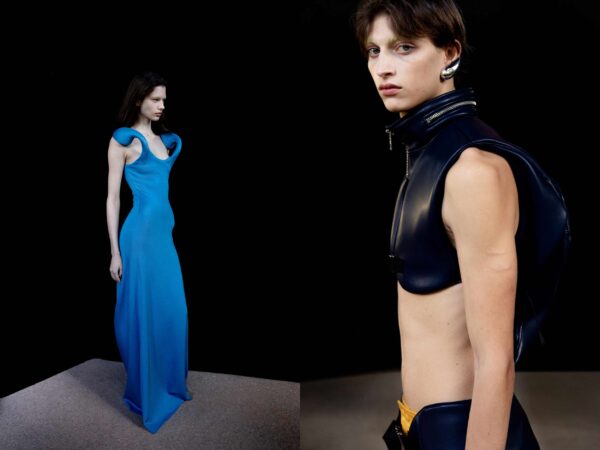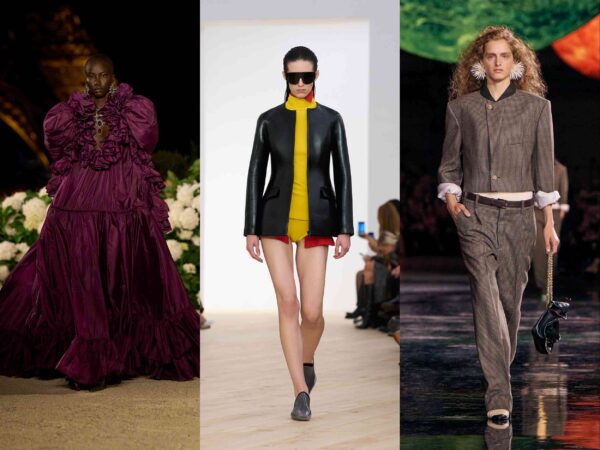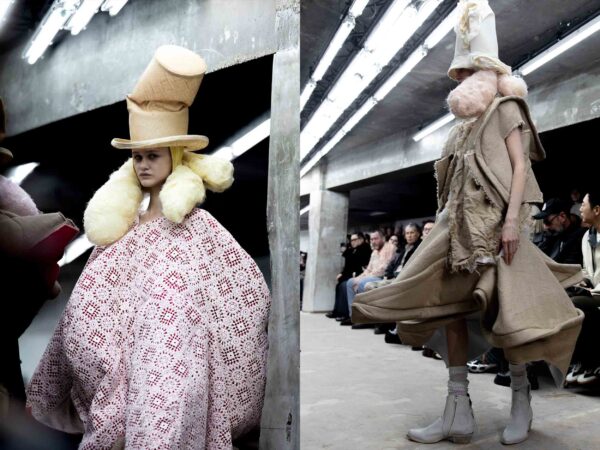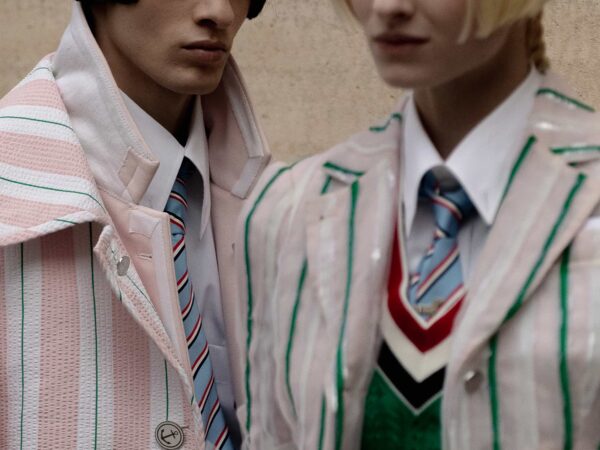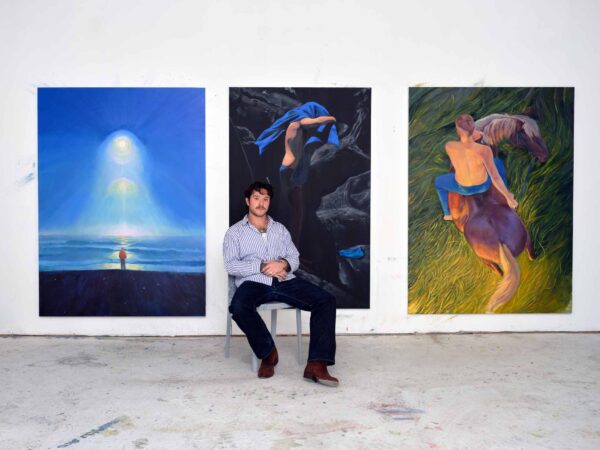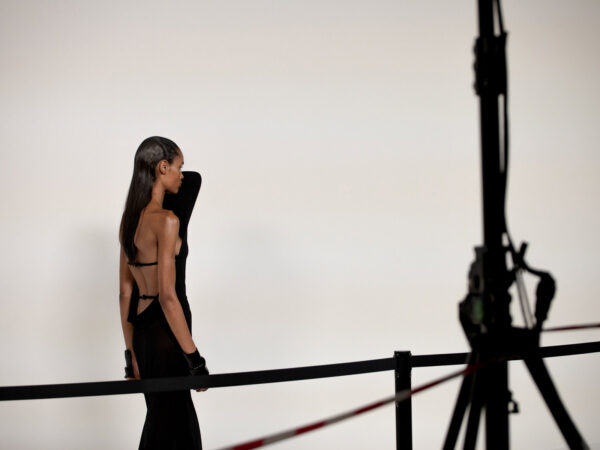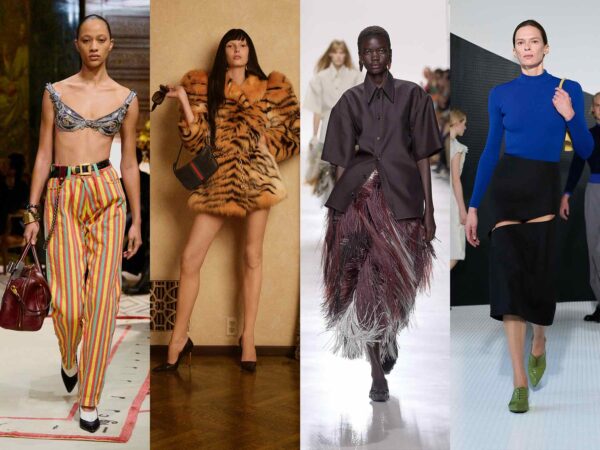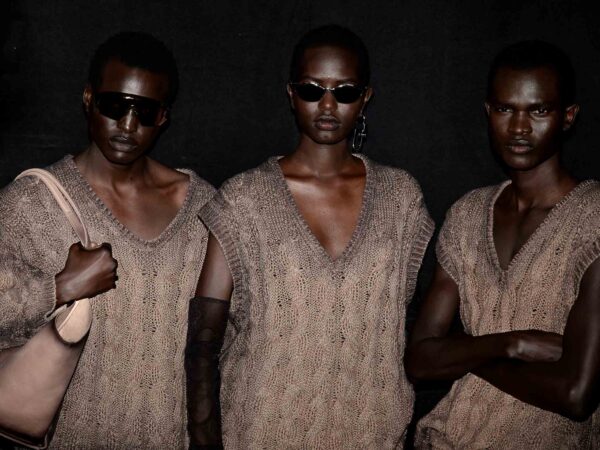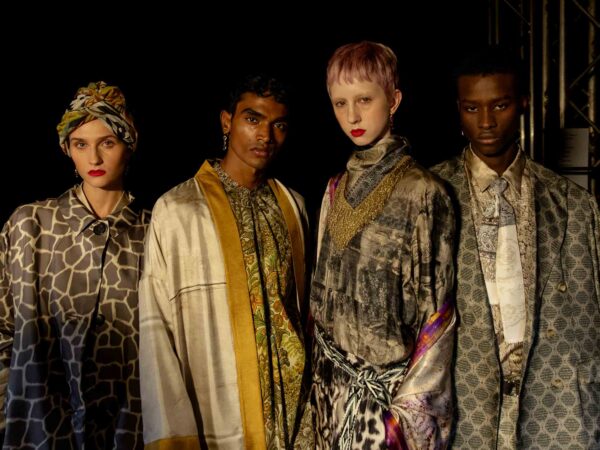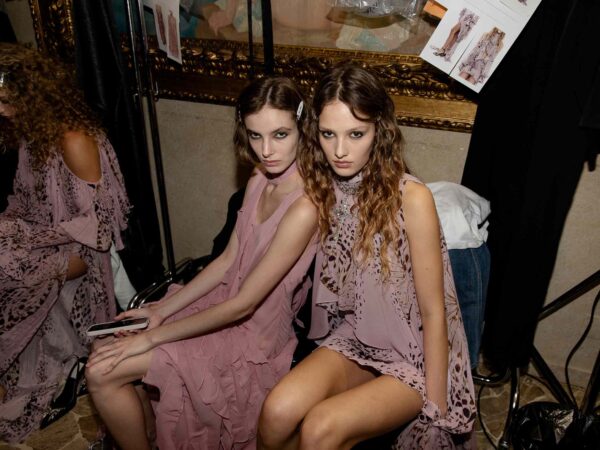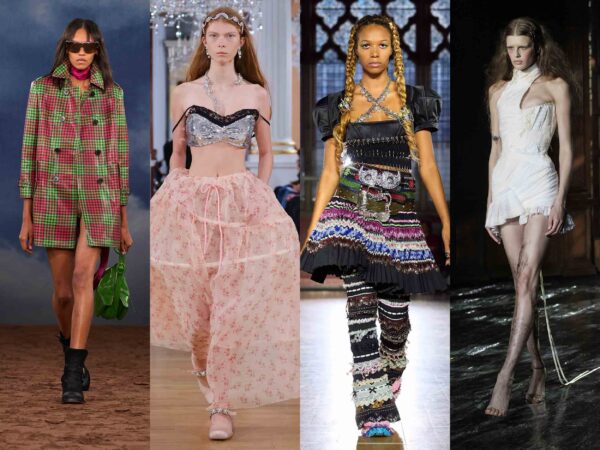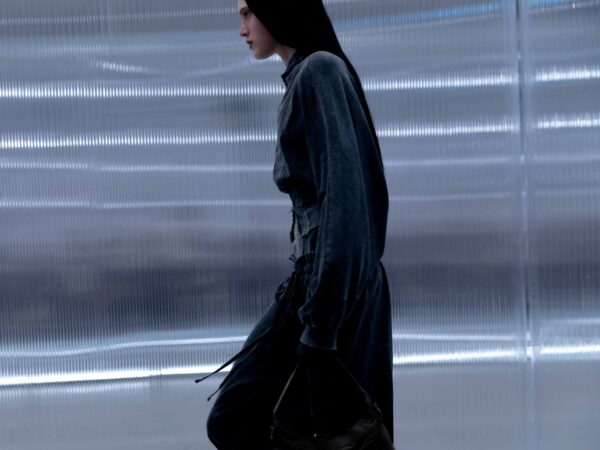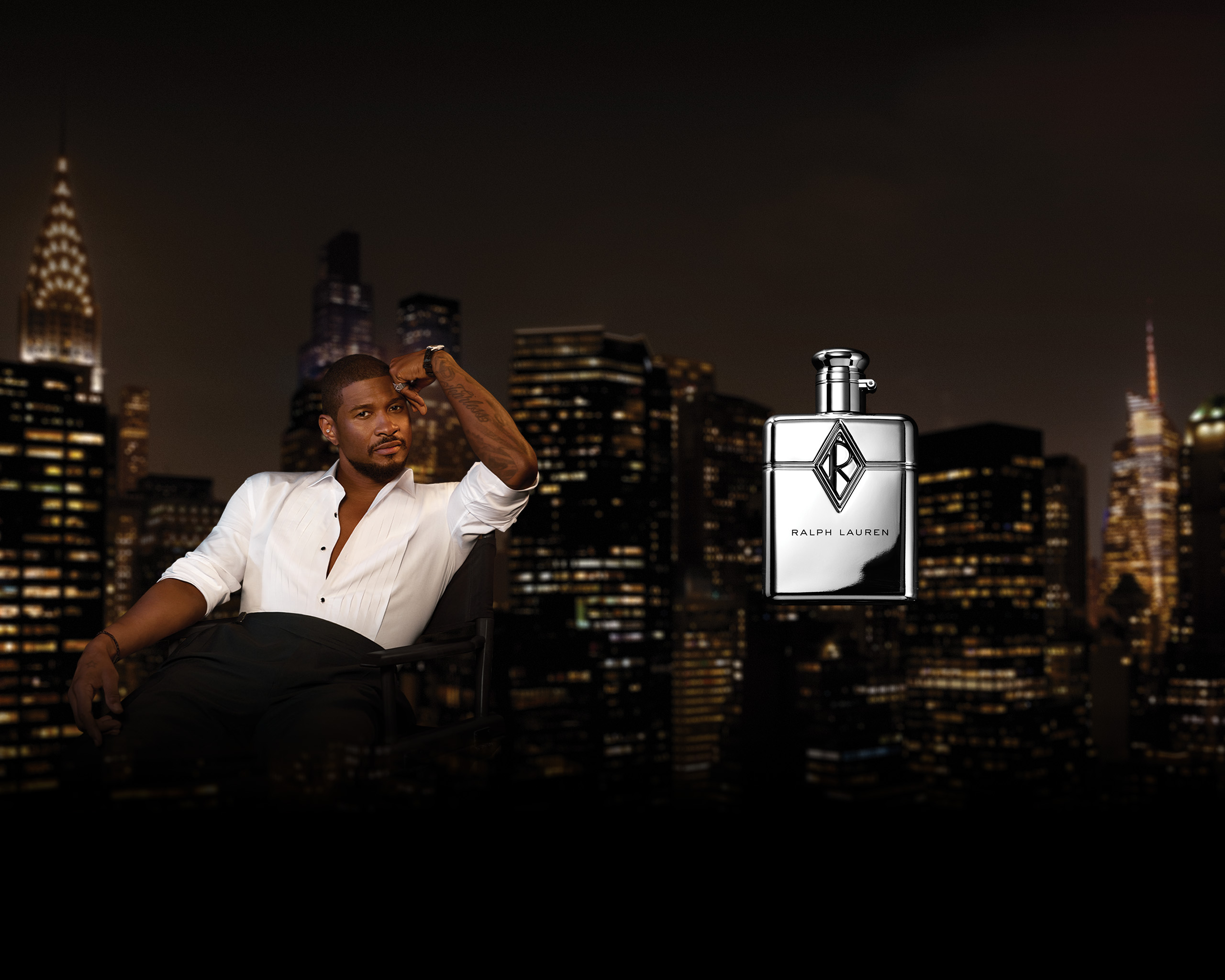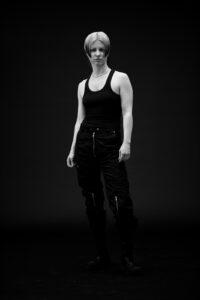
As partners in life, love, and work, they DJ internationally, perform punk shows, study music, walk runways, and finish each other’s sentences in conversation with Katie Rex, featuring portraits by Berghain bouncer Mischa Fanghaenel
Between New York’s after-hours and Berlin’s basements, Dominga Huidobro and Ariana Paoletti found each other—now they’re building a sanctuary of their own. Together, they lead ABOV, an emerging FLINTA collective grounded in refuge and liberation. Tracing back to the 1970s in Berlin from a lineage of intersectional spaces, FLINTA stands for Female, Lesbian, Intersex, Nonbinary, Trans, Agender, refining inclusive phrasing for some of the queer community’s most excluded groups.
Dominga is a Chilean polymath, having long blurred the lines between her craft and limitless artistic endeavors. Her genre-agnostic live outfit, Föllakzoid, has been touring globally in popular rock venues and avant garde spaces since 2007. In recent years, she’s redefined herself as a DJ, dismantling expectations of the live artist by reframing her musical practice through an experimental lens. The allure of her ethereal essence extends beyond music; she was selected to score and walk in ⱯNꓕONIO ACUARIO’s SS 2026 runway presentation at Madrid Fashion Week.
Ariana, who performs as Volvox, has been a bastion of the underground for nearly two decades. Born in Brazil and raised in Buffalo, New York, they have traversed the winding pathways of alternative music, fashion, and culture. The historical depths of their knowledge informs DJ sets rooted in darkwave, electro, techno, and other genre defying sounds—each imbued with a kind of clairvoyance, leading as much as empathizing with the crowd. This intuitiveness is a trait inherited from their mother and aunt, both healing practitioners who passed along a wealth of knowledge steeped in technique.
Together, Dominga and Volvox create a ceremonial voyage that extends beyond the dancefloor. Through their boundless creativity and personal intimacy, they’re dismantling the politics of nightlife. . In a conversation with Katie Rex, they explore the romantic mysticism and artistic practices that draw them together as a unified force.
Katie Rex: How did the two of you meet?
Dominga Huidobro: In this life or past?
Katie: We can really get into it…
Dominga: We believe we’ve been encountering each other in many lives—it’s very effortless. But in this life, we weren’t familiar with each other until we met in Berlin a couple of years ago.
Katie: When you started building a home in New York with Ariana, did you feel like the city started breeding a new life into your artistic practice?
Dominga: My record label, Sacred Bones, is from New York City, so I’ve been performing in the city throughout the last decade. Not just playing in rock venues like Bowery Ballroom or Rough Trade, but also performing at techno parties.
Now we have a home in New York and also Berlin, but I like to say I live inside of Ariana’s rib cage and Ariana lives inside of mine. Since we travel so much, our sense of home doesn’t change depending on the city we are in. It’s more about being together in the world. In terms of starting to develop the musical identity within the scenes currently active in New York City, we’ve encountered welcoming communities and a super supportive audience. It feels a bit more grounding for me than other places and has allowed us to platform ABOV.
Katie: In creating this mutual collaboration, how has it affected the output of your solo projects?
Dominga: It’s been complementary for the both of us. It handles many facets of my personal work. We’re so aligned energetically, artistically, and culturally; it feels like we’re doing each a bit less than we were before. But in the output, it’s somehow more efficient and effective than when we were on our own. It’s really cool. We’ve been able to stop making unnecessary efforts and let each other do what creates the best outcome.
Ariana Paoletti: I saw myself as more alternative because I didn’t relate to what was being pushed on the commercial side of the industry. Now I’m more open to the hi-fi domains and I recognize and appreciate the value in sonic weaponry that has a very defined character. I don’t feel the need to distance myself with sound, because we’re innovative in our message and politics. It’s been great to feel exceedingly more comfortable with letting go of expectations and external validations. Growing with modernity and embracing where sounds originate from in a technological perspective, allows us to incorporate our inherent rebellious attitude in ways that are more digestible. It allows our message to spread further in a smartly subversive way.
It also allows me to have a bit more fun, or just be sort of more playful with my personal direction. I do also enjoy more percussive styles, the inclusion of vocals, or more melodic elements. A less serious presentation. I really relish the opportunity to be playful and expansive with my personal sets now. In order to actually create a definably different show that allows me as an artist to…
Dominga: …Give continuity with the path you are doing individually.
Ariana: Yes.
Dominga: It’s a reclamation of the pathways that open up in the artform, but also reflecting on the multi-dimensional identities within each person. We’re all about not being boxed into just a DJ, model, a couple, or just FLINTA. We’ve booked DJs like Nastia Reigel and Annika Henderson. One artist is a well known techno DJ and the other a live musician, but both simultaneously have new projects. Nastia has a band Rosa Damask that is fantastic and Annika plays as a DJ. Our dream scenario is for artists in the live music space to be able to perform their electronic side, or on the electronic side be able to platform any other talents they might have.
Katie: How do you see the ABOV expanding outside of club spaces?
Dominga: I see it in the way that the old slogan “art changes the world” is commonly misunderstood as one piece of art transforming the outside. In actuality, how it works is that if your art or your space touches one individual intimately, that perspective will change the person’s perception of the world. That shift is so profound that it expands from individual to individual, changing its own core, ultimately leading to all reality changing. We’re not pursuing any particular outcome, yet we’re grateful and super fascinated by the receiving individuals becoming collective transformations of how they perceive themselves in the world and how the world perceives them.
Katie: Both of your artistries are more complex than sound, playing into your metaphysical synchronicity. What is it about the sound, visual, and spiritual that create this cohesion? How do you feel that all of these elements come together?
Dominga: We’re on a path that sheds previous armors that we’ve developed in order to get us where we are, be it musically, spiritually, or culturally. By removing those layers, the final product becomes this beautiful experience of daring to become more of the authentic self. A path that’s not only healing, but represents a change for women like us. At the same time, it’s healing for us as artists and creates a more pure connection with the music. We feel more naked, but more confident.
Katie: You both have a fine-tuned personal style. How does that speak with your creative outputs?
Dominga: My grandmother used to call me a clothing hanger, in a complimentary way. I once heard from a fan, “I love the way you hold yourself.” It stuck with me as a core guiding energy, whether I’m performing or talking to you in an interview or just like being alone. It permeates towards Ariana’s world. They’re the boss of the mega fashion archive and have years of expertise in style.
Katie: Ariana, how do you tell a story through clothing?
Ariana: Clothing has always been a process of self discovery. Being an archival dealer and secondhand buyer is like being a treasure hunter. In that way, I’m looking to discover who I am through pieces that I resonate with. It’s such a joy—you never know when you’re going to find something that really gives you that feeling. It’s such an interesting collaboration with the unknown, when all of the right elements come together.
Dominga: Lately, I’ve been rapidly schooled in the ancestral arts of fashion archives. As a trans woman, it feels super important to not only exist in the fashion world on the edges of the experimental bandwagon, but also to reclaim the classics.
Katie: How do you feel that you connect with each other through style and representing each other’s individuality?
Ariana: There’s an implicit trust that’s been developed. For example, there was a time she put an outfit together for me that I wasn’t totally comfortable with at first, but I just decided to go with it anyway. Of course, it absolutely slayed. Being able to open new avenues of self discovery and self vision through our vision of each other and trusting that process, it’s like being in love with your stylist.
Katie: You’re redefining public perceptions of love and intimacy as a creative unit. So many artists who partner with each other, get lost in the joining. It doesn’t seem that there’s much duality, but you both still keep your individuality.
Dominga: This wasn’t at all part of the plan. We were just into each other and had our own things going on. It was never a prospect to even perform together. They came to my shows as part of the audience and I kissed them from the stage. I went to their shows and would dance in the booth, the girlfriend. About eight months into the relationship we tried playing together and it all came together organically. It’s still not the core of our relationship.
Katie: Now that you’re traveling the globe together and separately, what do you hope the energy that you’re bringing into these new spaces does for people and how does your interaction blend with others?
Dominga: For a long time, we were on our own paths in non-welcoming environments. The live music scene is famously male dominated and very oppressive towards women. It was the same case for Ariana in techno. We were used to having to deal with all of this friction in our lives. Simultaneously, we were creating a safe space between each other and things on the outside started becoming less compatible. The first impulse to sort of expand this magnetic field of “us” doesn’t come as an objective to transform something for someone, more than primarily to create a space for us to exist. It turns out, there were more people like us in need of spaces that were outside of the cis-heteronormative masculine gaze. It comes from an organic expansion of where and how we can be ourselves.
Ariana: What sort of ways would you see that our performances could evolve with different elements that we haven’t included yet?
Dominga: The first layer would be multimedia experiences and the audience surrounding us. As a second layer, the inclusion of different spatial audio installations, followed closely by the use of classical elements like piano, violin, and folkloric patterns. Then again, classical arts like ballet—why not? We could perform around ancient pyramids during an eclipse.
Katie: Would you refer to yourself as a composer?
Dominga: A musical decomposer. A composer adds elements to a narration or a past or a visual part in order to create an arc with a resolution. As a musical decomposer, nice to meet you, I subtract elements in order to spend time with the objective of dissolving time perception, also understood as trans.
Katie: Do you feel that with decomposition it allows for more space for regrowth and newness?
Dominga: Absolutely, that’s the main aspect. Letting go of old mechanisms, structures, words or styles, and just hold the form for the law of attraction to do its thing.
Ariana: Something that I perceived is the information sharing capability of Dominga’s sound amalgamation. She shares the capability of sound transference to many multiple information streams at once. For example, you can watch a film and see many scenes quickly while your brain creates a pattern of information based on what you’re seeing with your eyes. I think that there’s a very underutilized thread of capability with sound that allows your mind to pull up many references at once. I’ve noticed that my mind is able to thread many more streams of information through sound reference now—this is the sound from a movie, the sound of a seal, the sound of the Large Hadron Collider. In combining all of those at once, it more directly accesses a deeper emotional archive of understanding, within myself and within others. It’s super impactful and my mind is able to absorb more and relativize more information through audio than it has been through visual media or reading. With that capability, combined with a visual video element, it allows us to transfer a transformational amount of data through our sets that’s going to be evolutionary in the future.
Dominga: We’re just actors of the current paradigmatical shift in the era we’re living in. The emission message receiver linearity is being broken by multiple inputs of multiple formats being showered at everyone all the time. It inevitably leads to a new way of understanding things that has to do with breaking linearity and being able to process multiple inputs of information at the same time, trans-dimensionality.
We’re very proud of the work we’ve done with ABOV. It’s been a real gift in our path as people and musicians. To find a place in a city that has welcomed us, with the help of a female led team of very experienced promoters to trust in us, it’s been a cornerstone in our lives to be able to exist in this very new space and to see how necessary it was. We’re living every second to work towards the continuity of this initiative in New York, Berlin, and the world.
Ariana: We want to continue to support a wave of cultural development that will ultimately grow well beyond our personal efforts and become something that is such a cultural norm that our participation in it matters or…
Dominga:…doesn’t. Hopefully, us being authors is something that ultimately becomes dissolved in the universality of the space we are pushing. That’s the goal.


